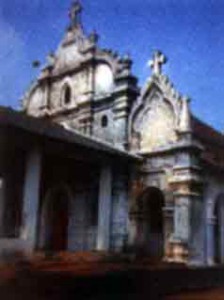Syrian Christian Orthodox Church: Jose George
Associated with the Dept. of English St. Albert’s College Ernakulam, Kerala.
The study of the Syrian Orthodox Church is basically a documentation on the Jacobite Syrian churches. The Syrian Orthodox Church is believed to have originated as a result of the missionary activities of St. Peter, the Apostle of Antioch, capital of Syria in 37 A.D., who established the Antiochion tradition also known as the Syrian orthodox tradition.
Syrian orthodox church occupies an important position among the ancient independent churches of the world. The Syrian Patriarchs of Antioch are successors of St. Peter. They are the head of the Syrian orthodox churches.
In Kerala, foundation of Syrian orthodox church is ascribed to St. Thomas and the missionary enterprises of Syria. It is believed that St. Thomas came to Muziris (present Kodungallur) in A.D. 52 from Edessa, capital of Eastern Syria during the time of king Gondophornes. According to another belief Christianity spread in Kerala by the efforts of Cana Thoma, 3 bishops of Edessa, clergymen and Syrian families in A.D. 345. Since there are no historical or anthropological evidences, it is difficult to make foolproof statement of the origin of the Syrian Christians of Kerala.
The traditional Christians of Kerala are called Malankara Syrian Christians. Before the Portuguese arrived in 1498, Christians were divided into 2 sects – Thekkumbhavar (southerners) and Vadakkumbhavar (northerners). The Syrian orthodox Christians are also known as Jacobite Christians. The term Jacobite originated from the name of St. Yacoub Bourdana, the Metropolitan of Edessa (A.D. 543). Jacobites, in church history means admirers of St. Yacoub of Edessa. The headquarters of Syrian orthodox churches or the Jacobites churches is in Damascus, capital of Syria.
Architectural features of the Syrian orthodox church comprises of Gothic, Jewish Synagogues and Hindu temple architectures all fused into the frame of Malankara Syrian orthodox church.
The customs of the Jacobite Syrians are combination of east and west. Within a strictly defined oriental system, western system is fused as an organic spirit in the space-time structure which is impossible to decode. The organizational set up of the community is a paradigm of the power structure of the west. The church follows a hierarchical system of administration in which the Patriarch of Antioch is the spiritual head of all the believers. The Catholics of Malankara are under his jurisdiction. Under the jurisdiction of the Catholicos, there are bishops who are assigned to administer the diocese. Each diocese is divided into a number of parishes which are spiritually governed by the priests and physically managed by an elected male body of the parishioners. Partial autonomy is granted to the elected body. Women are not permitted into the administrative affairs, or to lead any ritual worships or ceremonies. The community is operated in a strict patriarchal system as well as structure. Financially each parish is an independent unit. Remuneration to the priest is given from the fiscal funds. In addition to the monthly remuneration, a priest can also enjoy the individual remuneration fixed for saying qurbana (worship or mass) or performing various types of rituals.
Priesthood is a vocation. The priest plays the role of ‘father’ to the community. Traditionally priests were trained in the gurukula (where the teacher imparts knowledge to his deciple) system. An elderly priest acts as the guru or teacher. Today that system has been changed. Priests are systematically trained and educated in seminaries. The priests and deacons are usually married. Once they are ordained, they are abstained from marriage. Married priests are not permitted to become bishops. Unmarried priests are not supposed to hear the confession of women. Aspirants to the priesthood are selected from aristocratic families and send to the seminaries for formal training for about five years. After death, the bishop is buried in the Matbhaha (sacred place where only priests and assistants are permitted to enter) and the deacons and aspirants are buried in between the Haicala and Prakaram, place for common people. Others are buried in the courtyard or in the cemetey. Jacobite Syrians do not use footwears inside the church or in the households. There are no specific dress pattern for males but women have a special traditional dress that resembles the dress of a Brahmin woman. Modesty is visible in their costume. A woman does not expose her body. Grown up girls do not go out with boys. Marriages are usually arranged by the elders. Divorce is not permitted without any substantial reason. A widow or widower is permitted to marry, but in such occasions rings and crowns are not blessed as in the regular marriages. Those who marry from outside the caste are excommunicated. Kinship marriages are forbidden. Dowry system is in practice and a common accepted custom among the members of the community, though it is prohibited by law. In traditional Jacobite Syrian families, women do not eat with the male members of the family. Daughters do not get heirship of family property. If there is no male issue in a family, a male boy is adopted and made heir of the family. Qurbana is the central ritual of the Jacobite Syrians. All adults are supposed to participate in the qurbana on sundays. After the service, communion is shared among the participants as a symbol of unity in Christ.
In the present times it is observed that social services and missionary activities are being reduced. As more and more believers are being lured towards modernization, participation in rituals and worships are becoming less. This change is drastically effecting the traditional value system.
[ Newsletter | List of Newsletter ]





